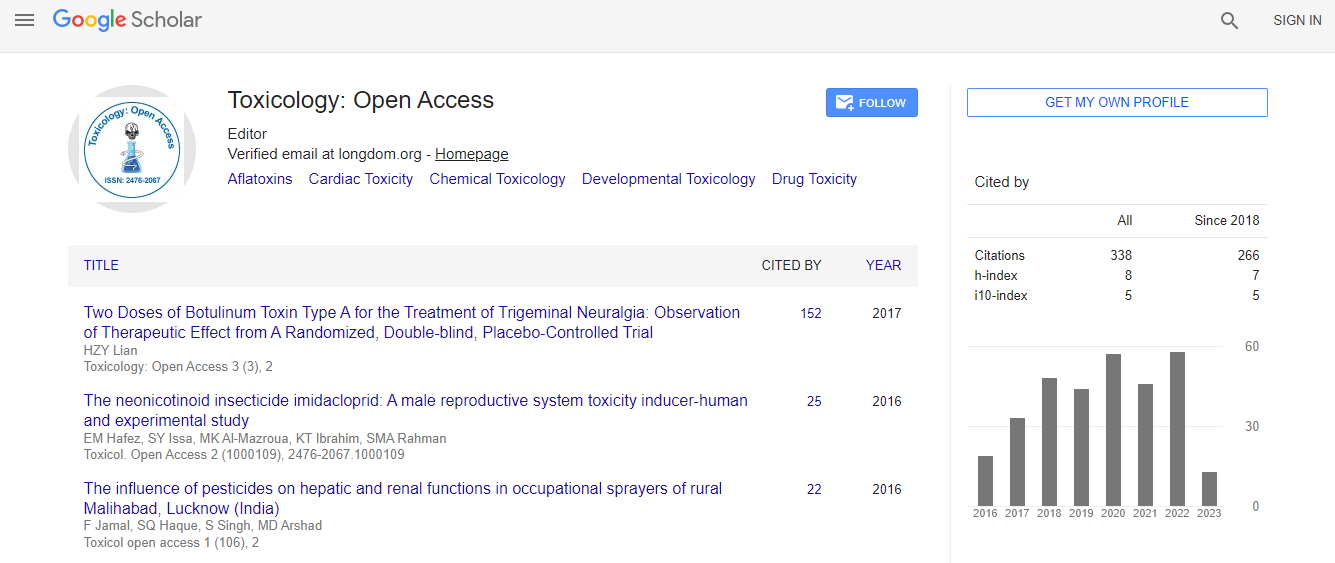Our Group organises 3000+ Global Conferenceseries Events every year across USA, Europe & Asia with support from 1000 more scientific Societies and Publishes 700+ Open Access Journals which contains over 50000 eminent personalities, reputed scientists as editorial board members.
Open Access Journals gaining more Readers and Citations
700 Journals and 15,000,000 Readers Each Journal is getting 25,000+ Readers
Google Scholar citation report
Citations : 336
Toxicology: Open Access received 336 citations as per Google Scholar report
Indexed In
- Google Scholar
- RefSeek
- Hamdard University
- EBSCO A-Z
- Geneva Foundation for Medical Education and Research
- Euro Pub
- ICMJE
Useful Links
Related Subjects
Share This Page
Celastrol induces apoptosis-mediated cell death in multi-drug resistance human nasopharyngeal cancer cells
14th World Congress on Toxicology and Pharmacology
Ming Ju Hsieh and Mu-Kuan Chen
Changhua Christian Hospital, Taiwan
Posters & Accepted Abstracts: Toxicol Open Access
Abstract
Nasopharyngeal carcinoma (NPC) belongs to squamous cell carcinoma that occurs in the epithelial lining of the nasopharynx. Because of the anatomical position close to the cervical lymph node, some patients have a distant metastasis at the time of diagnosis that leads to treatment failure. Although early stages have a high curability and excellent prognosis, advanced NPC urgently requires new drugs developed to reinforce the effectiveness of therapy without noticeable side effects. Celastrol, a chemical compound isolated from the root extracts of Tripterygium wilfordii (thunder god vine) and Celastrus regelii has been reported to possess anticancer potential. The aim of the present study was to determine the anticancer activity of celastrol and further elucidate the underlying molecular mechanisms. In this study, we first demonstrated that celastrol potently suppressed cell viability in MDR-NPC cell lines. Treatment of cells with celastrol induced G2/M arrest and apoptosis. Further studies showed that celastrol increased the expression of cleaved caspase-3, -8, -9 and subsequently activated apoptosis. Moreover, we found that celastrol-induced activation of bax, bim and t-Bid involved in the apoptosis. The expression of anti-apoptotic proteins Bcl-2 was significantly reduced, but expression of Bcl-XL was no significantly change after treatment of celastrol. Celastrol treatment also increased the expression of Fas, DcR2, DR5, RIP and TRADD. The cytotoxic effect of celastrol on NPC cells is mainly due to apoptosis, mediated by Fas-Fas ligand and mitochondrial pathway. These results suggested that celastrol could be a potential anticancer agent for NPC. Recent Publications 1. Lin H F, Hsieh M J, Hsi Y T, Lo Y S, Chuang Y C, Chen M K, Chien S Y (2017) Celastrol-induced apoptosis in human nasopharyngeal carcinoma is associated with the activation of the death receptor and the mitochondrial pathway. Oncol Lett; 14(2): 1683-1690. 2. Chen J C, Hsieh M J, Chen C J, Lin J T, Lo Y S, Chuang Y C, Chien S Y, Chen M K (2016) Polyphyllin G induce apoptosis and autophagy in human nasopharyngeal cancer cells by modulation of AKT and mitogen-activated protein kinase pathways in vitro and in vivo. Oncotarget; 7(43): 70276-70289.Biography
Ming Ju Hsieh is a Biochemistry Doctor, specializing in biochemistry, biotechnology, tumor metastasis, apoptosis and other research areas. He has considerable experience in research results in the hospital and research units.
Email:170780@cch.org.tw

 Spanish
Spanish  Chinese
Chinese  Russian
Russian  German
German  French
French  Japanese
Japanese  Portuguese
Portuguese  Hindi
Hindi 